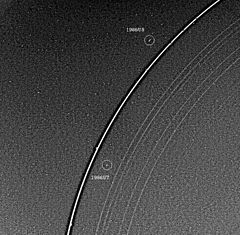 Cordelia (lower-middle, inside of bright ring), discovery image from Voyager 2 | |
| Discovery | |
|---|---|
| Discovered by | Richard J. Terrile / Voyager 2 |
| Discovery date | January 20, 1986 |
| Mean orbit radius | 49751.722 ± 0.149 km[1] |
| Eccentricity | 0.00026 ± 0.000096[1] |
| Orbital period | 0.33503384 ± 0.00000058 d[1] |
| Inclination | 0.08479 ± 0.031° (to Uranus' equator)[1] |
| Satellite of | Uranus |
| Physical characteristics | |
| Dimensions | 50 × 36 × 36 km[2] |
| Mean radius | 20.1 ± 3 km[2][3][4] |
| Surface area | ~5500 km²[5] |
| Volume | ~38,900 km³[5] |
| Mass | ~4.4 × 1016 kg[5] |
| Mean density | ~1.3 g/cm³ assumed[3] |
| Equatorial surface gravity | ~0.0073 m/s²[5] |
| Escape velocity | ~0.017 km/s[5] |
| Rotation period | synchronous[2] |
| Axial tilt | zero[2] |
| Albedo | 0.08 ± 0.01 [6] 0.07[3][4] |
| Temperature | ~64 K[5] |
| | |
Cordelia (pronounced /kɔrˈdiːliə/ kor-DEE-lee-ə) is the innermost moon of Uranus. It was discovered from the images taken by Voyager 2 on January 20, 1986 and was given the temporary designation S/1986 U 7.[7] It was not detected again until the Hubble Space Telescope observed it in 1997.[6][8] Cordelia takes its name from the youngest daughter of Lear in William Shakespeare's King Lear. It is also designated Uranus VI.[9]
Unfortunately, other than its orbit,[1] radius of 20 km[2] and geometric albedo of 0.08[6] virtually nothing is known about it. At the Voyager 2 images Cordelia appears as an elongated object, the major axis pointing towards Uranus. The ratio of axises of the Cordelia's prolate spheroid is 0.7 ± 0.2.[2]
Cordelia acts as the inner shepherd satellite for Uranus' Epsilon ring.[10] Cordelia's orbit is within Uranus' synchronous orbit radius, and is therefore slowly decaying due to tidal deceleration.[2]
0 comments:
Post a Comment